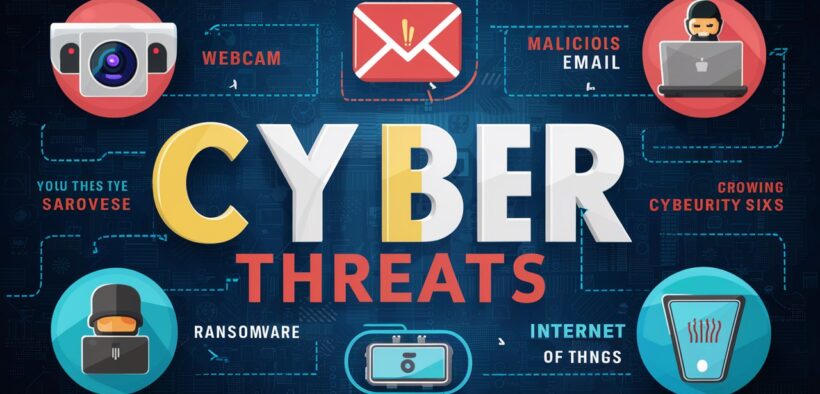5 Latest Trends In Cyber Threats
Share

The latest trends in cyber threats paint a concerning picture for businesses, with attackers constantly devising new methods to infiltrate systems and steal valuable data. The cybersecurity landscape is in a constant state of flux and the alarming statistics paint a grim picture. A report by Cybersecurity Ventures predicts global cybercrime costs to reach a staggering $10.5 trillion annually by 2025. This translates to businesses experiencing a cyberattack, on average, every 39 seconds according to IBM. Furthermore, the average cost of a data breach has skyrocketed to a record $4.24 million according to the Ponemon Institute. In this ever-changing threat environment, organizations must stay vigilant.
5 Evolving Cyber Threats Businesses Face
Here’s a closer look at five of the most concerning trends in cybersecurity threats that are keeping security professionals up at night:
- Ransomware’s Growing Impact- Ransomware attacks have evolved beyond data encryption. Adversaries are targeting critical infrastructure, disrupting operations and causing significant financial losses. The increased attack surface due to remote work environments presents a bigger challenge for organizations.
- Sophisticated Social Engineering Techniques- Social engineering continues to be a prevalent threat. Attackers are employing increasingly sophisticated tactics, including impersonation of trusted sources, smishing (SMS phishing), and social media manipulation, to bypass traditional security awareness programs and exploit human vulnerabilities.
- The Expanding Attack Surface of the IoT- The proliferation of internet-connected devices (IoT) creates a vast and vulnerable attack surface. Inherent security weaknesses in many IoT devices make them easy targets for unauthorized access and integration into botnets, potentially leading to large-scale attacks on critical systems.
- Cloud Security Challenges- Cloud migration offers numerous benefits, but it also introduces new security considerations. Inadequate security practices during cloud adoption can leave organizations exposed. Malicious actors are actively targeting cloud platforms to gain access to sensitive data.
- The AI and ML Cybersecurity Arms Race- Artificial intelligence (AI) and machine learning (ML) are becoming instrumental in both offensive and defensive cybersecurity strategies. AI-powered solutions offer enhanced threat detection and response capabilities. However, attackers are also leveraging AI and ML to develop more targeted and automated attacks, necessitating continuous improvement of AI/ML-based defenses to stay ahead of the curve.
5 Professional Actions Businesses Can Take To Combat Cybersecurity Threats
As these trends demonstrate, the cybersecurity landscape is a dynamic battleground. Understanding these evolving threats allows organizations to prioritize their defenses and invest in the right security solutions.
- Implement a Rigorous Patch Management Program- Prioritize consistent and timely patching of vulnerabilities across all software and operating systems. Unpatched systems are prime targets for exploitation. Businesses should leverage automation tools whenever possible to streamline patching processes and minimize the window of vulnerability.
- Enforce Multi-Factor Authentication (MFA) Company-Wide – MFA significantly enhances security by adding an extra layer of verification beyond just usernames and passwords. Businesses should enforce MFA for all user accounts, particularly those with access to sensitive data or critical systems. This could involve hardware tokens, fingerprint scans, or one-time codes sent via secure channels.
- Cultivate a Culture of Security Awareness Through Ongoing Training – Invest in ongoing security awareness training programs for all employees. These programs should educate employees on the latest social engineering tactics used by attackers, such as phishing emails and smishing. Training should emphasize how to identify suspicious behavior, recognize red flags, and report them promptly. Empowering employees with security knowledge makes them active participants in the organization’s cybersecurity posture.
- Proactively Identify and Mitigate Vulnerabilities Through Penetration Testing and Vulnerability Assessments – Regular penetration testing simulates cyberattacks to uncover vulnerabilities in systems and network configurations. Vulnerability assessments identify known weaknesses in software and hardware. By proactively conducting these assessments, businesses can prioritize patching efforts and implement additional security measures before attackers exploit these gaps.
- Develop and Regularly Test a Comprehensive Incident Response Plan- A well-defined incident response plan outlines the steps to take in the event of a security breach. This plan should address data containment, eradication, recovery, and communication protocols. Regular testing and updates ensure the plan’s effectiveness during a real-world attack. Having a clear plan minimizes confusion and allows for a swift and coordinated response to limit damage.
In essence, combating today’s cyber threats requires a proactive, multi-faceted approach. Businesses must prioritize consistent patching, enforce MFA, cultivate a security-aware workforce, and conduct regular vulnerability assessments and penetration testing. Developing and testing a comprehensive incident response plan ensures a swift and coordinated response to breaches, minimizing damage. By embracing these measures and staying informed, businesses can navigate the evolving threat landscape with confidence.










